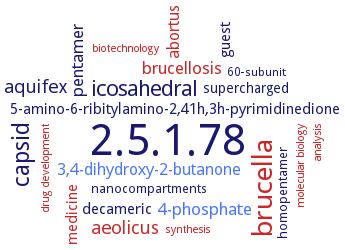2.5.1.78: 6,7-dimethyl-8-ribityllumazine synthase
This is an abbreviated version!
For detailed information about 6,7-dimethyl-8-ribityllumazine synthase, go to the full flat file.

Word Map on EC 2.5.1.78 
-
2.5.1.78
-
brucella
-
capsid
-
icosahedral
-
aquifex
-
aeolicus
-
brucellosis
-
4-phosphate
-
pentamer
-
abortus
-
3,4-dihydroxy-2-butanone
-
5-amino-6-ribitylamino-2,41h,3h-pyrimidinedione
-
medicine
-
guest
-
decameric
-
supercharged
-
homopentamer
-
nanocompartments
-
60-subunit
-
biotechnology
-
synthesis
-
molecular biology
-
analysis
-
drug development
- 2.5.1.78
- brucella
-
capsid
-
icosahedral
-
aquifex
- aeolicus
- brucellosis
- 4-phosphate
-
pentamer
- abortus
- 3,4-dihydroxy-2-butanone
-
5-amino-6-ribitylamino-2,41h,3h-pyrimidinedione
- medicine
-
guest
-
decameric
-
supercharged
-
homopentamer
-
nanocompartments
-
60-subunit
- biotechnology
- synthesis
- molecular biology
- analysis
- drug development
Reaction
Synonyms
6,7-dimethyl-8-(d-ribityl)lumazine synthase, 6,7-dimethyl-8-ribityllumazine synthase, 6,7-dimethyl-8-ribityllumazine synthase 1, 6,7-dimethyl-8-ribityllumazine synthase 2, 6,7-dimethyl-8-ribityllumazine-synthase, AaLS, BLS, DMRL synthase, DMRL synthase 2, heavy riboflavin synthase, LcLS1, LcLS2, lumazine synthase, lumazine synthase 1, lumazine synthase 2, lumazine synthase/riboflavin synthase complex, lumazinesynthase/riboflavin synthase complex, lumazinesynthase/riboflavin synthase complex, icosahedral capsid of 60 beta subunits enclosing a triplet of alpha subunits, luminazine synthase, MbtLS, MJ0303, Pbls, RIB4, ribE, RibH, ribH1, RibH1 protein, RibH2, type I lumazine synthase, type II lumazine synthase


 results (
results ( results (
results ( top
top






